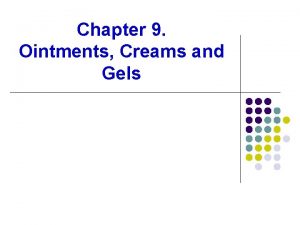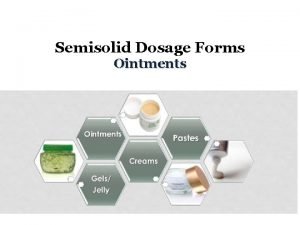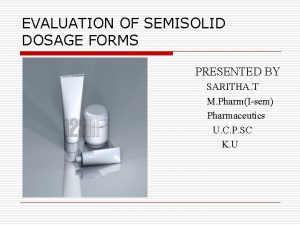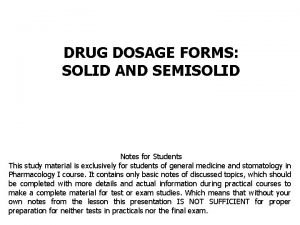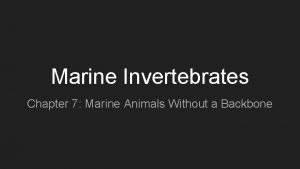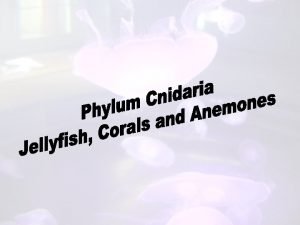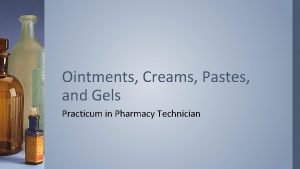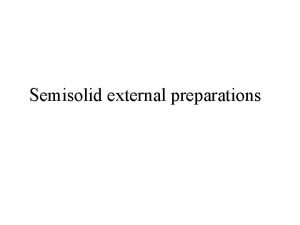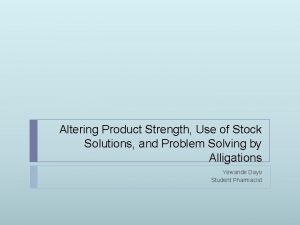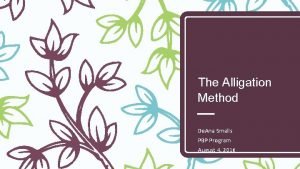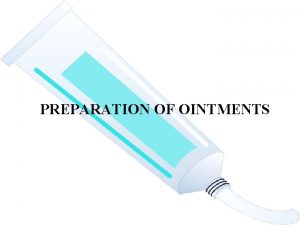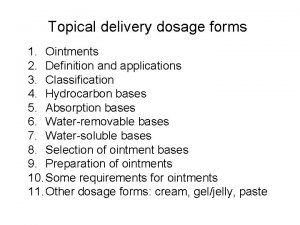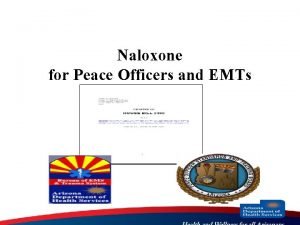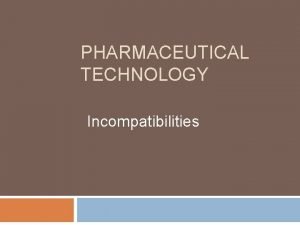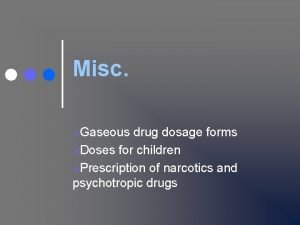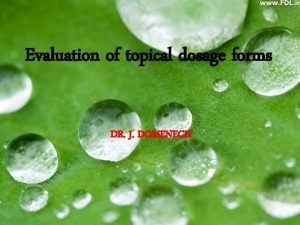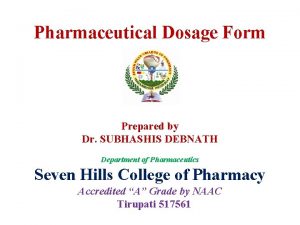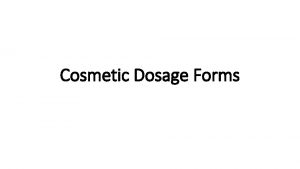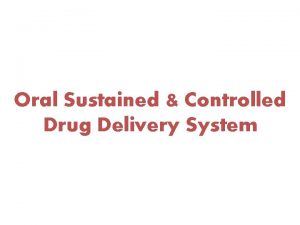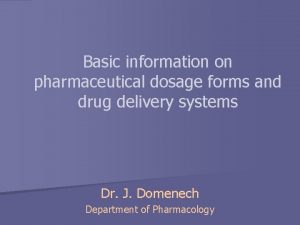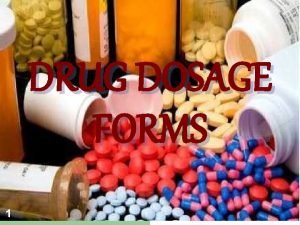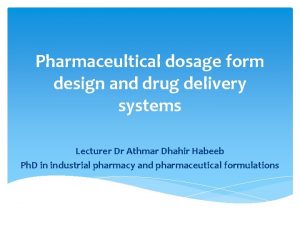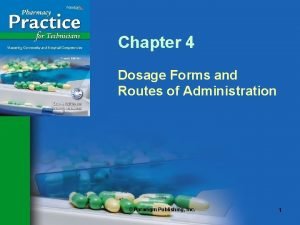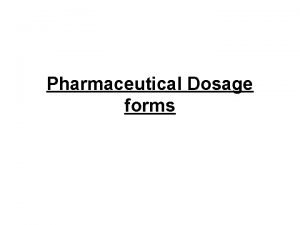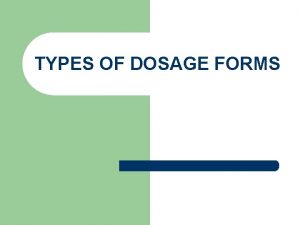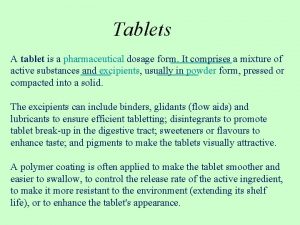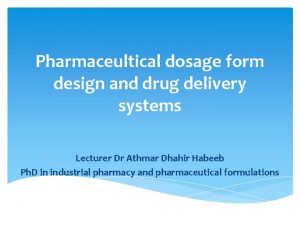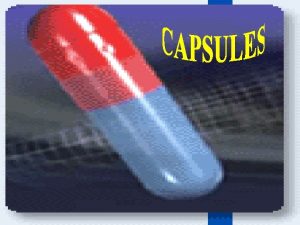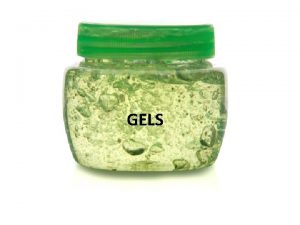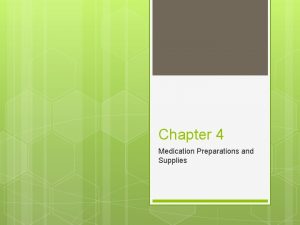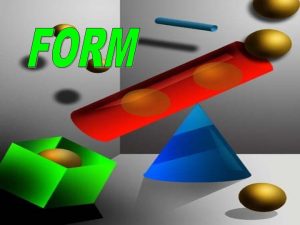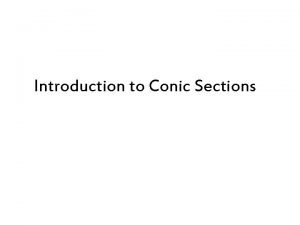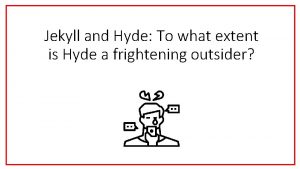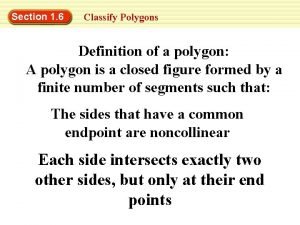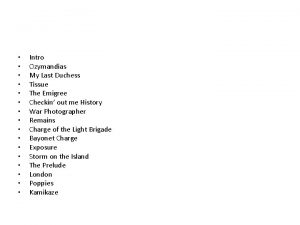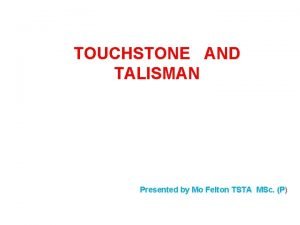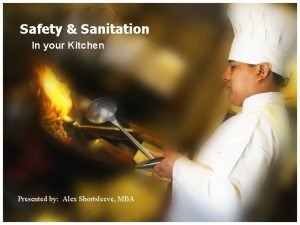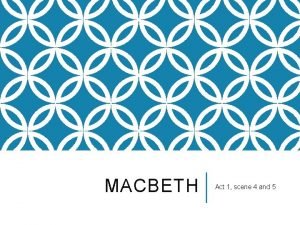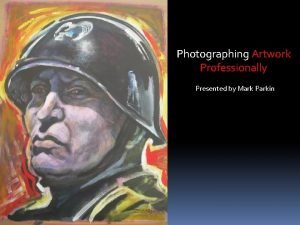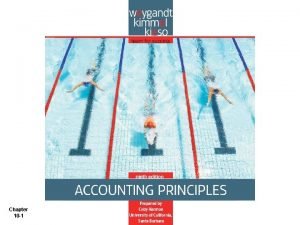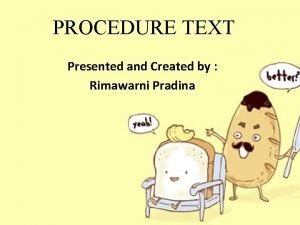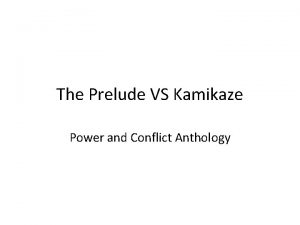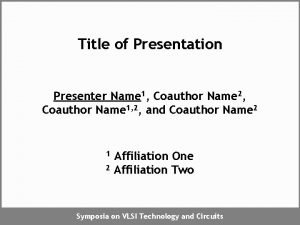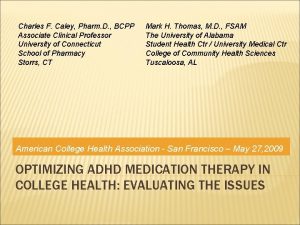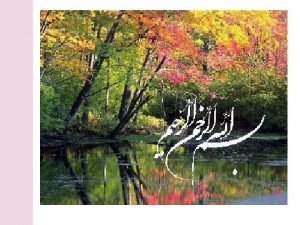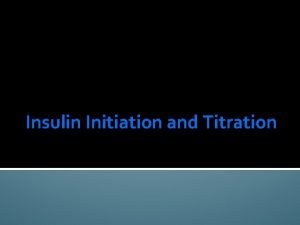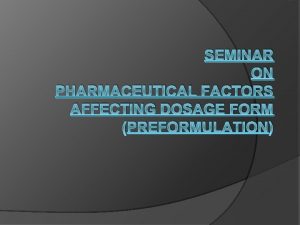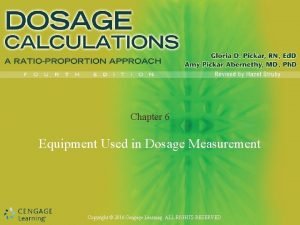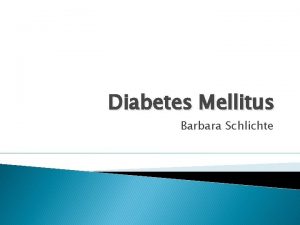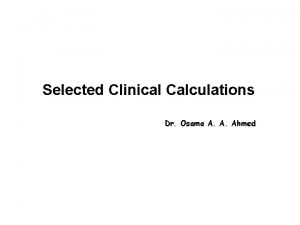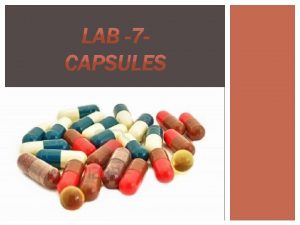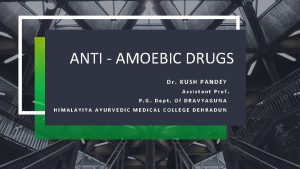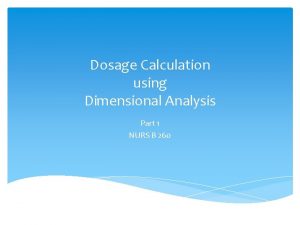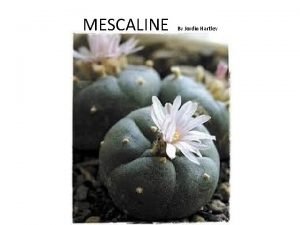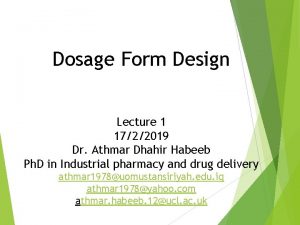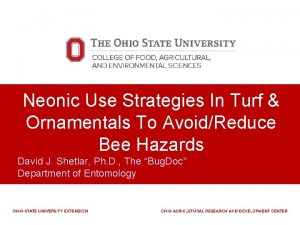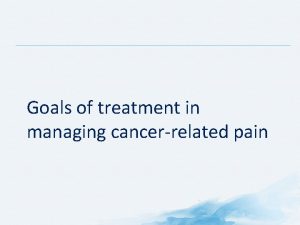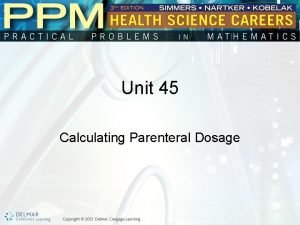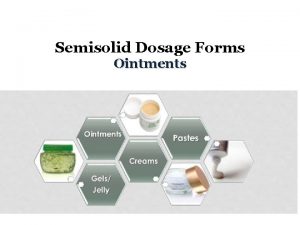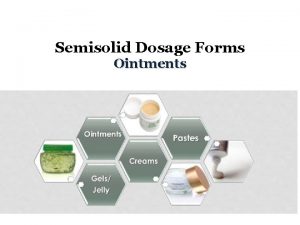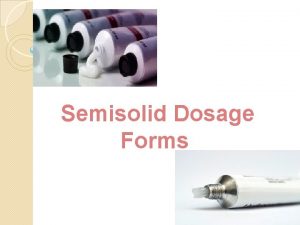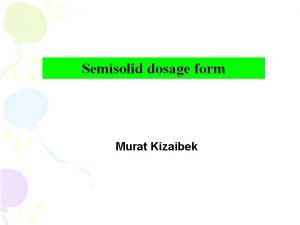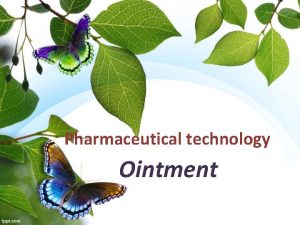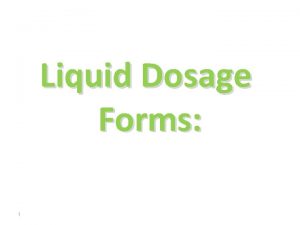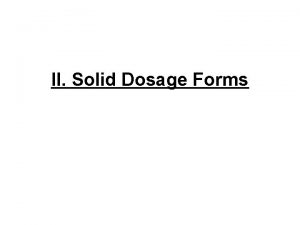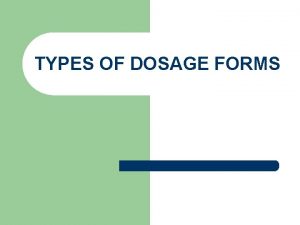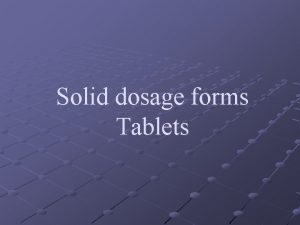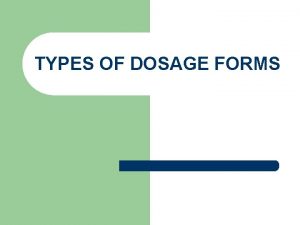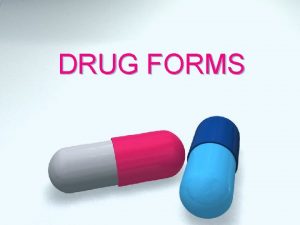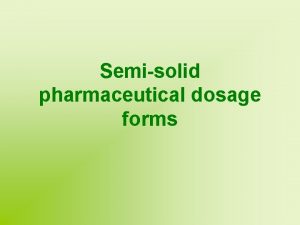SEMISOLID DOSAGE FORMS Ointments Pastes Jellies poultices Presented
































































































- Slides: 96

SEMISOLID DOSAGE FORMS - Ointments, Pastes, Jellies, poultices Presented By: Ms. Sneha Wankhede

content �a) Ointments: -Type of ointments, classification and selection of dermatological vehicles. � Preparation and stability of ointments �(b) Pastes: Differences between ointments and pastes. Bases of pastes. Preparation of pastes and their preservation. �(c) Jellies: An introduction to the different types of jellies and their preparation. �(d) An elementary study of poultice.

Ointments �Ointments are soft semisolid preparations meant for external application to the skin or mucous membrane. �They usually contains medicament which is either dissolved or suspended in the base. �They have emollient and protective action.

�Creams are semisolid emulsions and are generally of softer consistency and lighter than ointments. �They are less greasy and are easy to apply. �Pastes are semisolid preparations for external application that differ from similar products in containing a high proportion of finely powdered medicaments. �They are stiffer and are usually employed for their protective action and for their ability to absorb serious discharges from skin lesions.

�Thus when protective, rather than therapeutic action is desired, the formulation pharmacists will favor a paste, but when therapeutic action is required, he will prefer ointments and creams. �Jellies are transparent or translucent, non-greasy, semisolid preparation mainly used externally. �The gelling agent may be gelatin, starch, tragacanth, sodium alginate or cellulose derivative (e. g. carboxy methyl cellulose).

�OINTMENT �Definition: Ointments are semisolid preparations for application to the skin or mucosa. �The ointment bases are almost always anhydrous and generally contain one or more medicaments in suspension or solution. �

Characteristics of an ideal ointment � 1. It should be chemically and physically stable. � 2. It should be smooth and free from grittiness. � 3. It should melt or soften at body temperature and be easily applied. � 4. The base should be non-irritant and should have no therapeutic action. � 5. The medicament should be finely divided and uniformly distributed throughout the base

Classification of ointments ØAccording to their therapeutic properties based on penetration of skin. ØAccording to their therapeutic uses.

�Ointments classified according to their therapeutic properties based on penetration are as follows: �(a) Epidermic, � (b) Endodermic, � (c) Diadermic

(a) Epidermic ointments �These ointments are intended to produce their action on the surface of the skin and produce local effect. �They are not absorbed. �They act as protective, antiseptic and parasiticide. (b) Endodermic ointments �These ointments are intended to release the medicaments that penetrate into the skin. They are partially absorbed and acts as emollients, stimulants and local irritants. (c) Diadermic ointments �These ointments are intended to release the medicaments that pass through the skin and produce systemic effects.

According to therapeutic uses the ointments are classified as follows: �(i) Acne treatment : resorcinol, sulfur. �(ii) Antibiotics : Used to kill microorganisms. e. g. bacitracin, chlortetracycline, neomycin. �(iii) Antieczematous : Used to stop oozing and exudation from vesicles on the skin. e. g. hydrocortisone, coal tar, ichthamol, salicylic acid. �(iv) Antifungal : Used to inhibit or kill the fungi e. g. benzoic acid, salicylic aid, nystatin, clotrimazole, etc. �(v) Anti-inflammatory : Used to relieve inflammatory, allergic and pruritic conditions of the skin e. g. betamethasone valerate, hydrocortisone, triamcinolone acetonide

�(vi) Antipruritic : Used to relieve itching e. g. benzocaine, coal tar. �(vii) Antiseptic : Used to stop sepsis e. g. ammoniated mercury, zinc oxide. �(vii) Astringent : Reduces the secretion of glands or discharge from skin surface e. g. calamine, zinc oxide, aluminium acetate and subacetate, acetic acid and tannic acid. �(ix) Counter irritant : These are applied locally to irritate the intact skin, thus reducing or relieving another irritation or deep seated pain. e. g. capsicum oleoresin, iodine (Iodex), methyl salicylate. �(x) Dandruff treatment : e. g. salicylic acid and cetrimide (cetyl trimethyl ammonium bromide)

�(xi) Emollient : Used to soften the skin (for example in the dry season) e. g. soft paraffin �(xii) Keratolytic : Used to remove or soften the horny layer of the skin e. g. resorcinol, salicylic acid and sulfur. �(xi) Keratoplastic : Tends to increase thickness of horny layer e. g. coal tar. �(xii) Parasiticide : These ointments destroy or inhibit living infestations such as lice and ticks e. g. benzyl benzoate, gamma-benzene hexachloride (GBH), sulfur etc. �(xiii) Protective : Protects the skin from moisture, air, sun rays or other substances such as soaps or chemicals. e. g. silicones, titanium dioxide, calamine, zinc oxide, petrolatum.

OINTMENT BASES �The ointment base is that substance or part of an ointment preparation which serves as carrier or vehicle for the medicament. �An ideal ointment base should be inert, stable, smooth, compatible with the skin, non-irritating and should release the incorporated medicaments readily. �Classification of ointment bases: � 1. Oleaginous bases � 2. Absorption bases � 3. Water-miscible bases � 4. Water soluble bases

OLEAGINOUS BASES �These bases consists of oils and fats. The most important are the �Hydrocarbons i. e. petrolatum, paraffins and mineral oils. �The animal fat includes lard. �The combination of these materials can produce a product of desired melting point and viscosity. �(a) Petrolatum (Soft paraffin) �This is a purified mixture of semi-solid hydrocarbons obtained from petroleum or heavy lubricating oil. �Yellow soft paraffin (Petrolatum; Petroleum jelly) �This a purified mixture of semisolid hydrocarbons obtained from petroleum. It may contain suitable stabilizers like, antioxidants e. g. a-tocopherol (Vitamin E), butylated hydroxy toluene (BHT) etc. �Melting range : 38 to 560 C.

�White soft paraffin (White petroleum jelly, White petrolatum) �This a purified mixture of semisolid hydrocarbons obtained from petroleum, and wholly or partially decolorized by bleaching the yellow soft paraffin. �Melting range : 38 to 560 C. �Use: The white form is used when the medicament is colourless, white. This base is used in �Dithranol ointment B. P. �Ammoniated Mercury and Coal tar ointment B. P. C. �Zinc ointment B. P. C.

�(b) Hard paraffin (Paraffin) �This is a mixture of solid hydrocarbons obtained from petroleum. �It is colourless or white, odorless, translucent, waxlike substance. It solidifies between 50 and 570 C and is used to stiffen ointment bases.

�(c) Liquid paraffin (Liquid petrolatum, ; White mineral oil) �It is a mixture of liquid , hydrocarbons obtained from petroleum. It is transparent, colourless, odourless, viscous liquid. �On long storage it may oxidize to produce peroxides and therefore, it may contain tocopherol or BHT as antioxidants. �It is used along with hard paraffin and soft paraffin to get a desired consistency of the ointment. Tubes for eye, rectal and nasal ointments have nozzles with narrow orifices through which it is difficult to expel very viscous ointments without the risk of bursting the tube. To facilitate the extrusion upto 25% of the base may be replaced by liquid paraffins.

�Advantages of hydrocarbons bases: �(i) They are not absorbed by the skin. They remain on the surface as an occlusive layer that restricts the loss of moisture hence, keeps the skin soft. �(ii) They are sticky hence ensures prolonged contact between skin and medicament. �(iii) They are almost inert. They consist largely of saturated hydrocarbons, therefore, very few incompatibilities and little tendency of rancidity are there. �(iv) They can withstand heat sterilization, hence, sterile ophthalmic ointments can be prepared with it. �(v) They are readily available and cheap.

�Disadvantages of hydrocarbon bases; �(i) It may lead to water logging followed by maceration of the skin if applied for a prolonged period. �(ii) It retains body heat, which may produce an uncomfortable feeling of warmth. �(iii) They are immiscible with water; as a result rubbing onto the surface and removal after treatment both are difficult. �(iv) they are sticky, hence makes application unpleasant and leads to contamination of clothes. �(v) Water absorption capacity is very low, hence, these bases are poor in absorbing exudate from moist lesions.

�ABSORPTION BASE �The term absorption base is used to denote the water absorbing or emulsifying property of these bases and not to describe their action on the skin. �These bases (some times called non emulsifiable ointment bases) are generally anhydrous substances which have the property of absorbing (emulsifying) considerable quantity of water yet retaining its ointment-like consistency. � Preparations of this type do not contain water as a component of their basic formula but if water is incorporated a W/O emulsion results.

�Wool Fat (anhydrous lanolin) �It is the purified anhydrous fat like substance obtained from the wool of sheep. �· It is practically insoluble in water but can absorb water upto 50% of its own weight. Therefore it is used in ointments the proportion of water or aqueous liquids to be incorporated in hydrocarbon base is too large. �· Due to its sticky nature it is not used alone but is used along with other bases in the preparation of a number of ointments. �e. g. Simple ointment B. P. contains 5% and the B. P. eye ointment base contains 10% woolfat.

�Hydrous Wool Fat (Lanolin) �· It is a mixture of 70 % w/w wool fat and 30 % w/w purified water. It is a w/o emulsion. Aqueous liquids can be emulsified with it. �· It is used alone as an emollient. �· Example: - Hydrous Wool Fat Ointment B. P. C. , Calamine Coal Tar Ointment.

�Wool Alcohol �It is the emulsifying fraction of wool fat. Wool alcohol is obtained from wool fat by treating it with alkali and separating the fraction containing cholesterol and other alcohols. It contains not less than 30% of cholesterol. �Use: �· It is used as an emulsifying agent for the preparation of w/o emulsions and is used to absorb water in ointment bases. �· It is also used to improve the texture, stability and emollient properties of o/w emulsions. �Examples : - Wool alcohol ointment B. P. contains 6% wool alcohol and hard, liquid and soft paraffin.

Beeswax �It is purified wax, obtained from honey comb of bees. �It contains small amount of cholesterol. It is of two types: (a) yellow beeswax and (b) white beeswax. �Use: �Beeswax is used as a stiffening agent in ointment preparations. �Examples: -Paraffin ointment B. P. C. contains beeswax.

Cholesterol �It is widely distributed in animal organisms. Wool fat is also used as a source of cholesterol. �Use: - It is used to increase the water absorbing power of an ointment base. �Example: - Hydrophilic petroleum U. S. P. contains: �Cholesterol 3% �Stearyl alcohol 3% �White beeswax 8% �White soft paraffin 86%

Advantages of absorption bases: �(i) They are less occlusive nevertheless, are good emollient. �(ii) They assist oil soluble medicaments to penetrate the skin. �(iii) They are easier to spread. �(iv) They are compatible with majority of the medicaments. �(v) They are relatively heat stable. �(vi) The base may be used in their anhydrous form or in emulsified form. �(vii)They can absorb a large quantity of water or aqueous substances. �Disadvantages: Inspite of their hydrophilic nature, absorption bases are difficult to wash.

WATER MISCIBLE BASES �They are miscible with an excess of water. Ointments made from water-miscible bases are easily removed after use. �There are three official anhydrous water-miscible ointment bases: �Example: �Emulsifying ointment B. P. - contains anionic emulsifier. �Cetrimide emulsifying ointment B. P. - contains cationic emulsifier �Cetomacrogol emulsifying ointment B. P. - contains non-ionic emulsifier � �Uses: they are used to prepare o/w creams and are easily removable ointment bases �e. g. Compound Benzoic Acid Ointment (Whitfield’s Ointment) - used as antifungal ointment.

Advantages of water miscible bases: �Readily miscible with the exudates from lesions. �Reduced interference with normal skin function. �Good contact with the skin, because of their surfactant content. �High cosmetic acceptability, hence there is less likelihood of the patients discontinuing treatment. �Easy removal from the hair.

WATER SOLUBLE BASES �Water soluble bases contain only the water soluble ingredients and not the fats or other greasy substances, hence, they are known as grease-less bases. �Water soluble bases consists of water soluble ingredients such as polyethylene glycol polymers (PEG) which are popularly known as “carbowaxes” and commercially known as “macrogols”. �They are a range of compounds with the general formula: � CH 2 OH. (CH 2 OCH 2) n CH 2 OH �

�The PEGs are mixtures of polycondensation products of ethylene and water and they are described by numbers representing their average molecular weights. Like the paraffin hydrocarbons they vary in consistency from viscous liquids to waxy solids. �Example: � Macrogols 200, 300, 400 - viscous liquids � Macrogols 1500 - greasy semi-solids � Macrogols 1540, 3000, 4000, 6000 - waxy solids. � �Different PEGs are mixed to get an ointment of desired consistency.

Advantages of PEGs as ointment base: � �(a) They are water soluble; hence, very easily can be removed from the skin and readily miscible with tissue exudates. �(b) Helps in good absorption by the skin. �(c) Good solvent properties. Some water-soluble dermatological drugs, such as salicylic acid, sulfonamides, sulfur etc. are soluble in this bases. �(d) Non-greasy. �(e) They do not hydrolyze, rancidify or support microbial growth. �(f) Compatibility with many dermatological medicaments

Disadvantages: � �(a) Limited uptake of water. Macrogols dissolve when the proportion of water reaches about 5%. �(b) Reduction in activity of certain antibacterial agents, e. g. phenols, hydroxybenzoates and quaternary compounds. �(c) Solvent action on polyethylene and bakelite containers and closures. �Certain other substances which are used as water soluble ointment bases include tragacanth, gelatin, pectin, silica gel, sodium alginate, cellulose derivatives, etc.

FACTORS GOVERNING SELECTION OF AN IDEAL OINTMENT BASE �A)Dermatological factors � 1. Absorption & penetration. � 2. Effect on skin function � 3. Miscibility with skin secretion and serum. � 4. Compatibility with skin secretion. � 5. Freedom from irritant effect. � 6. Emollient properties. � 7. Ease of application. �B)Pharmaceutical factors

1. Dermatological factors (a) Absorption and Penetration: �‘Penetration’ means passage of the drug across the skin i. e. cutaneous penetration, and ‘absorption’ means passage of the drug into blood stream. �· Medicaments which are both soluble in oil and water are most readily absorbed though the skin. �· Whereas animal and vegetable fats and oils normally penetrate the skin. �· Animals fats, e. g. lard and wool fat when combined with water, penetrates the skin. �· o/w emulsion bases release the medicament more readily than greasy bases or w/o emulsion bases.

�(b) Effect on the skin �· Greasy bases interfere with normal skin functions i. e. heat radiation and sweating. They are irritant to the skin. �· o/w emulsion bases and other water miscible bases produce a cooling effect due to the evaporation of water.

(c) Miscibility with skin secretion and serum � �Skin secretions are more readily miscible with emulsion bases than with greasy bases. Due to this the drug is more rapidly and completely released to the skin.

d) Compatibility with skin secretions: �The bases used should be compatible with skin secretions and should have p. H about 5. 5 because the average skin p. H is around 5. 5. Generally neutral ointment bases are preferred.

�(e) Non-irritant �All bases should be highly pure and bases specially for eye ointments should be non-irritant and free from foreign particle. f) Emollient properties �Dryness and brittleness of the skin causes discomfort to the skin therefore, the bases should keep the skin moist. For this purpose water and humectants such as glycerin, propylene glycol are used. Ointments should prevent rapid loss of moisture from the skin.

(g) Ease of application and removal �The ointment bases should be easily applicable as well as easily removable from the skin by simple washing with water. �Stiff and sticky ointment bases require much force to spread on the skin and during rubbing newly formed tissues on the skin may be damaged. �

2. Pharmaceutical factors (a) Stability �Fats and oils obtained from animal and plant sources are prone to oxidation unless they are suitably preserved. � Due to oxidation odour comes out. This type of reactions are called rancidification. Lard, from animal origin, rancidify rapidly. �Soft paraffin, simple ointment and paraffin ointment are inert and stable. � Liquid paraffin is also stable but after prolonged storage it gets oxidized. � Therefore, an antioxidant like tocopherol (Vit -E) may be incorporated. Other antioxidants those may be used are butylated hydroxy toluene (BHT) or butylated hydroxy anisole (BHA). �

(b) Solvent properties �Most of the medicaments used in the preparation of ointments are insoluble in the ointment bases therefore, they are finely powdered and are distributed uniformly throughout the base.

(c) Emulsifying properties �Hydrocarbon bases absorbs very small amount of water. �Wool fat can take about 50% of water and when mixed with other fats can take up several times its own weight of aqueous solution. �Emulsifying ointment, cetrimide emulsifying ointment and cetomacrogol emulsifying ointment are capable of absorbing considerable amount of water, forming w/o creams.

(d) Consistency �The ointments produced should be of suitable consistency. They should neither be hard nor too soft. They should withstand climatic conditions. Thus in summer they should not become too soft and in winter not too hard to be difficult to remove from the container and spread on the skin. �The consistency of an ointment base can be controlled by varying the ratio of hard and liquid paraffin.

PREPARATION OF OINTMENTS �A well-made ointment is �(a) Uniform throughout i. e. it contains no lumps of separated high melting point ingredients of the base, there is no tendency for liquid constituents to separate and insoluble powders are evenly dispersed. �(b) Free from grittiness, i. e. insoluble powders are finely subdivided and large lumps of particles are absent. Methods of preparation must satisfy this criteria.

PREPARATION OF OINTMENTS �Trituration �Fuson method �Chemical reaction method �Emulsification method

Trituration �Most commonly used method �Trituration, in which finely-subdivided insoluble medicaments are evenly distributed by grinding with a small amount of the base or one of its ingredients followed by dilution with gradually increasing amounts of the base �For uniformity � 1. finely powder the solid medicaments (Solids are finely powdered are passed through a sieve (# 250, # 180, #125). ) � 2. weigh the required qty of an ointment base. �triturate the solid medicaments with small qty of base on ointment slab With the help of small SS spatula untill a homogeneous product is formed

� 3. add remaining qty of base and mix untill the medicament is uniformly is mixed with it. �Example: �(i) Simple ointment B. P. contains �Wool fat 50 g �Hard paraffin 50 g �Cetostearyl alcohol 50 g �White soft paraffin 850 g � �Type of preparation: Absorption ointment base

�Procedure: �Melt Hard paraffin and cetostearyl alcohol on water-bath. Wool fat and white soft paraffin are mixed and stirred until all the ingredients are melted. �If required decanted or strained and stirred until cold and packed in suitable container.

Whitfield ointment (Compound benzoic acid ointment B. P. C. ) �Formula: �Benzoic acid, in fine powder 6 gm �Salicylic acid, in fine powder 3 gm �Emulsifying ointment 91 gm � �Method: Benzoic acid and salicylic acid are sieved through No. 180/125 # sieves. They are mixed on the tile with small amount of base and levigated until smooth and dilute gradually. �(ii) Salicylic acid sulphur ointment B. P. C.

Fusion �in which ingredients are melted together and stirred to ensure homogeneity. �When an ointment base contain a number of solid ingredients such as white beeswax, cetyl alcohol, stearic acid, hard paraffin, etc. as components of the base, it is required to melted them �Substance with highest melting point melted first

Ointments prepared by Fusion method: �The components are melted in the decreasing order of their melting point i. e. the higher m. p. substance should be melted first, the substances with next melting point and so on. � The medicament is added slowly in the melted ingredients and stirred thoroughly until the mass cools down and homogeneous product is formed. �Advantages: �This will avoid over-heating of substances having low melting point.

� Cautions: � (i) Melting time is shortened by grating waxy components (i. e. beeswax, wool alcohols, hard-paraffin, higher fatty alcohols and emulsifying waxes) by stirring during melting and by lowering the dish as far as possible into the water bath so that the maximum surface area is heated. � (ii) The surface of some ingredients discolors due to oxidation e. g. wool fats and wool alcohols and this discolored layers should be removed before use. � (iii) After melting, the ingredients should be stirred until the ointment is cool are not to cause localized cooling, e. g. by using a cold spatula or stirrer, placing the dish on a cold surface (e. g. a plastic bench top) or transferring to a cold container before the ointment has fully set. If these precautions are ignored, hard lumps may separate. � (iv) Vigorous-stirring, after the ointment has begun to thicken, causes excessive aeration and should be avoided. � (v) Because of their greasy nature, many constituents of ointment bases pickup dirt during storage, which can be seen after melting. This is removed from the melt by allowing it to sediment and decanting the supernatant, or by passage through muslin supported by a warm strainer. In both instances the clarified liquid is collected in another hot basin. � (vi) If the product is granular after cooling, due to separation of high m. p. constituents, it should be remelted, using the minimum of heat, and again stirred and cooled.

Ex: 1. wool alcohol ointment �Wool alcohol �Hard paraffin �Liquid paraffin �White soft paraffin 2. Cetrimide ointment 3. Coal tar ointment 6 g 24 g 60 g 10 g

preparation of ointment by chemical reaction �Certain chemical reactions are involved in preparing certain ointments for e. g non staining Iodine ointment �Fixed oils contains unsaturated fatty acids which reacts with iodine and iodine gets attached to either side of double bond, therefore free iodine is not available in the preparation �Ointment containing combined iodine: �CH 3. (CH 2)7. CH=CH. (CH 2)7. COOH +I 2 �=CH 3. (CH 2)7. CHI. (CH 2)7, COOH �Oleic acid + iodne= di-iodo stearic acid �Rx �Iodine ……………. . 50 gms �Arachis oil ……… 150 ml �Yellow soft paraffin ………. . 1000 gms

�Method: �(a) Iodine is finely powdered in a glass mortar and required amount is added to the oil in a glass-stoppered conical flask and stirred well. �(b) The oil is heated at 500 C in a water-bath and stirred continually. Heating is continued until the brown color is changed to greenish-black; this may take several hours. �(c) From 0. 1 g of the preparation the amount of iodine is determined by B. P. C. method and the amount of soft paraffin base is calculated to give the product the required strength. �(d) Soft paraffin is warmed to 400 C. The iodized oil is added and mixed well. No more heat is applied because this causes deposition of a resinous substance. �(e) The preparation is packed in a warm, wide-mouthed, amber color, glass bottle. It is allowed to cool without further stirring.

Ointment containing free iodine �Iodine is slightly soluble in most of fat and vegitable oil �But it is also soluble in concentrated solution of KI solution due to the formation of polyiodides ( KI. I 2, KI. 2 I 2, Ki. 3 I 3) EX: strong iodine ointment Iodine …. 2 g KI………. 2 g Wool fat …… 2 g Yellow soft paraffin ………. 38 g Water…………. 6 ml

�Procedure: �(i) KI is dissolved in water. I 2 is dissolved in it. �(ii) Woolfat and yellow soft paraffin are melted together over water bath. Melted mass is cooled to about 400 C. �(iii) I 2 solution is added to the melted mass in small quantities at a time with continuos stirring until a uniform mass is obtained. �(iv) It is cooled to room temperature and packed. �Use: - Ringworm in cattle.

�Strong Iodine Ointment B. Vet. C (British Veterinary Pharmacopoeia) is used to treat ringworm in cattle. It contains free iodine. At one time this type of ointments were used as counter-irritants in the treatment of human rheumatic diseases but they were not popular because: �(i) They stain the skin a deep red color. �(ii) Due to improper storage the water dries up and the iodine crystals irritate the skin, hence glycerol used some times to dissolve the iodine-potassium iodide complex instead of water

Emulsification method � 4. PREPARATION OF OINTMENTS BY EMULSIFICATION �An emulsion system contain an oil phase, an aqueous phase and an emulsifying agent. �For o/w emulsion systems the following emulsifying agents are used: Ø water soluble soap Ø cetyl alcohol Ø glyceryl monostearate Ø combination of emulsifiers: triethanolamine stearate + cetyl alcohol Ø non-ionic emulsifiers: glyceryl monostearate, glyceryl monooelate, propylene glycol stearate

�For w/o emulsion creams the following emulsifiers are used: � (i) polyvalent ions e. g magnesium, calcium and aluminium are used. � (ii) combination of emulsifiers: beeswax + divalent calcium ion �The viscosity of this type of creams prevent coalescence of the emulsified phases and helps in stabilizing the emulsion.

�Example: �Cold cream: � �Procedure: �Water immiscible components e. g. oils, fats, waxes are melted together over water bath (700 C). �Aqueous solution of all heat stable, water soluble components are heated (700 C). �Aqueous solution is slowly added to the melted bases with continuous stirring until the product cools down and a semi-solid mass is obtained. � � The aqueous phase is heated otherwise high melting point fats and waxes will immediately solidify on addition of cold aqueous solution

� STABILITY OF OINTMENTS � The ointments should remain stable from the time of preparation to the time when the whole of it is consumed by the user. � To stop microbial growth preservatives are added. Preservatives for ointment includes : p-hydroxy benzoates, phenol, benzoic acid, sorbic acid, methyl paraben, propyl paraben, quaternary ammonium compounds, mercury compounds etc. � The preservatives should not react with any of the component of the formulation. Plastic containers may absorb the preservative and thereby decreasing the concentration of preservative available for killing the bacteria. � Some ingredients like wool fat and wool alcohols are susceptible to oxidation. Therefore, a suitable antioxidant may be incorporated to protect the active ingredients from oxidation. � Incompatible drugs, emulsifying agents and preservatives must be avoided. The drugs which are likely to hydrolyze must be dispensed in an anhydrous base. � Humectants such as, glycerin, propylene glycol and sorbitol may be added to prevent the loss of moisture from the preparation. � Ointment must be stored at an optimum temperature otherwise separation of phases may take place in the emulsified products which may be very difficult to remix to get a uniform product. �

Pastes �Syllabus: � Differences between ointments and pastes. � Bases of pastes � Preparation of paste and their preservation. �Pastes are semisolid preparations for external application that differ from similar products in containing a high proportion of finely powdered medicaments.

BASES OF PASTES: 1. Hydrocarbon base: Soft paraffin and liquid paraffin are commonly used bases for the preparation of paste . Name of the preparation Active ingredients Base Use 1. Compound Zinc Paste B. P. 2. Compound Zinc & Salicylic acid Paste B. P. (Lassar’s Paste) 3. Coal tar paste 4. Dithranol paste compound 5. Aluminium paste B. P. C. (Baltimore Paste) Zinc oxide Soft paraffin Eczema, psoriasis. Zinc oxide & Salicylic acid Soft paraffin Eczema, psoriasis. Soft paraffin Eczema Coal tar Ring worm or psoriasis Dithranol Soft paraffin Aluminium oxide Protectant Liquid paraffin

2. Water miscible base: Name of the preparation Base Use 1. Resorcinol & sulfur Paste B. P. C. 2. Zinc & Coal tar Paste 3. Magnesium sulfate paste B. P. C. (Morison’s paste) 4. Titanium dioxide paste B. P. C. Emulsifying ointment Emulsifying wax Magnesium sulfate -45% Phenol in glycerol Suspension of Ti. O 2, Zn. O, light kaolin and red Fe 2 O 3 in glycerol + water. Dandruff, and are easily removable from the hair. Eczema Used to treat boils, because of their powerful osmotic effect of the salt and the glycerol. Absorbs exudates from weeping skin conditions.

3. Water soluble bases: Name of the preparation 1. Water soluble dental pastes 2. Triamcinolone Dental paste B. P. C. Base Neomycin sulfate Triamcinolone acetonide in an adhesive paste (Na. CMC, pectin, + gelatin) Use Sterilizing infected root canal Antiinflammatory

METHODS OF PREPARATION: �Like ointment, pastes are prepared by trituration and fusion methods. Trituration method is used when the base is liquid or semisolid. �Fusion method is used when the base is semisolid and/or solid in nature. �Preparation 1. �Name: Compound Zinc Paste �Formula �Zinc oxide, finely sifted 25 g �Starch, finely sifted 25 g �White soft paraffin 50 g �

�Type of preparation: Paste with semi-solid base prepared by fusion and trituration. �Procedure; �(a) Zinc oxide and starch powder are passed through No. 180 sieve. �(b) Soft paraffin is melted on a water bath. �(c) The required amount of powder is taken in a warm mortar, triturated with little melted base until smooth. Gradually rest of the base is added and mixed until cold.

�Preparation 2. �Name: Zinc and Coal tar Paste B. P. C. �Formula: �Zinc oxide, finely sifted �Coal tar �Emulsifying wax �Starch �Yellow soft paraffin. �

�Type of preparation: Paste with semi-solid base prepared by fusion. �Procedure: �Method-I �(a) Emulsifying wax is melted in a tared dish (70 0 C). �(b) The coal tar is weighed in the dish. Stirred to mix. �Soft paraffin is melted in a separate dish (700 C) and about half is added to the tar-wax mixture; stirred well. Remainder is added; stirred again until homogeneous. �Allowed to cool at about (300 C) and zinc oxide (previously passed through 180 mesh) and starch, in small amount with constant stirring. Stirred until cold.

�Method-II �Wax and paraffin melted together, mixed well and stirred until just setting. Powders are mixed on a slightly warm tile and the tar is incorporated. This method eliminates the risk of over heating. �

Paste(3 M) �Pastes are semisolid dosage form for external use they are dispersion of high concentration of insoluble powered substances in a fatty base or aqueous base. �Types of bases for pastes � Paste with gelatin base -A hot 2% gelatin solution is used which becomes jelly on cooling, to this 10 -15% glycerin is added which act as preservative and emollient and in this solution solid substances are incorporated example Unnas paste �Paste with starch base ( gelatinized or ungelatinised) In case of gelatinized paste 10% starch solution is prepared and gelatinized by heating and than glycerin is added in this solution solid substances are added, in case of ungelatinised paste large portion of starch powder is mixed with other solid ingredients and water to form the paste.

� Paste with tragacanth base also called as Bassorin pastes In this the tragacanth powder is mixed with alcohol and triturated briskly followed by addition of glycerin and water. � Paste with cellulose derivatives-cellulose ether are dissolve in cold water and allowed to stand overnight it forms jelly and in this solid substances are incorporated �Paste with pectin base-Pectin is triturated with medicament and glycerin followed by addition solution to form paste �Paste with colloidal base aluminum hydroxide and bentonite are used as colloidal base. The colloidal base is triturated with solid substances followed by addition of glycerin and water

Paste Ointment They contain high concentration of medicament. (starch, Zno. Caco 3) They contain low concentrate of insoluble medicament. (in the form of dissolved/suspended/emulsified) They are thick, stiffer, less greasy in They are soft & greasy in consistency They are more absorptive They are less absorptive. They resist to flow with increase in force of Application. They flow more easily with increase In force of application. The paste adheres to the skin. They do not adhere to the skin. They are used mainly as Antiseptic, They are mainly used as protective Protective. Emollient.

JELLIES �Definition: �Jellies are transparent or translucent, non-greasy, semisolid preparation generally applied externally. �They are used for �medication, � lubrication and � some miscellaneous applications.

�Types of jellies: �Medicated jellies �(i) Water soluble drugs like local anaesthetics, spermicides and antiseptics are suitable for incorporation in the jellies. �(ii) They are easy to apply and evaporation of the water content produces a pleasant cooling effect. The medicinal film usually adheres well and gives protection but is easily removed by washing when the treatment is complete. �e. g. �ephedrine sulfate jelly - used to arrest bleeding from nose. �pramoxine HCl , a local anaesthetic - relieves discomfort of pruritis and haemorrhoids. � phenylmercuric nitrate - as spermicidal contraceptive. �

�Lubricating jelly: �Catheters, items of eletrodiagnostic equipment, such as cystoscopes, and rubber gloves or finger stalls used for rectal and other examinations require lubrication before use. �The lubricants must be sterile for articles inserted into sterile regions of the body, such as urinary bladder. �For painful investigations a local anaesthetic may be included as in Lignocaine Gel B. P. C.

�Miscellaneous uses �The following are more specialized jellies �(a) Patch testing �Here the jelly is the vehicle for allergens applied to the skin to detect sensitivity. Several allergens may be applied on one person. The viscosity of the jelly and it leaves on drying help to keep the particles separate. �(b) Electrocardiography �to reduce electrical resistance between the patients skin and electrodes of the cardiograph, an electrode jelly may be applied. This contains Na. Cl to provide good conductivity and often pumice powder which, when applied onto the skin, removes part of the horny layer of the epidermis, the main layer of electrical resistance.

FORMULATION �Pharmaceutical jellies are usually prepared by adding a thickening agent such as tragacanth or carboxy methylcellulose (CMC) to an aqueous solution in which drug has been dissolved. �The mass is triturated in a mortar until a uniform product is obtained. �For the preparation of jellies whole gum is preferred rather than powdered gum because the former gives a clear preparation of uniform consistency. �The following gelling agents are used for the preparation of jellies.

�(i) Tragacanth �the main hydrophilic component of tragacanth that gels in water has been named bassorin - hence, tragacanth jellies are sometimes called bassorin paste. �The amount of gum required for a preparation varies with its use: �(a) For lubricating jelly 2 to 3%. �(b) Fro dermatological vehicles about 5%. �(c) For incorporation of ichthamol, resorcinol, salicylic acid and other medicaments, about 5% is generally used. All formulations contain alcohol and/or glycerol and/or a volatile oil to disperse the gum and prevent lumpiness when water is added. �(d) They vary in viscosity, due to the natural origin of the gum and variations in milling and storage. �(e) The film left on the skin tends to flake. �(f) Viscosity is rapidly lost outside the p. H range of 4. 5 to 7. 0; for example if benzoic acid is used as the preservative. �(g) They are susceptible to microbial growth.

�Example: �Formula �Ichthamol 1. 0 g �Tragacanth 2. 5 g �Alcohol 90% 5. 0 g �Glycerin 1. 0 g �Purified water q. s. 50. 0 g

�Procedure: �(i) Alcohol is taken in a 100 ml, wide mouthed jar; and then tragacanth is added to it. (The reverse order may lead to lump formation). Mixed well. �(ii) Water is added as quickly as possible and mixed. �(iii) Separately ichthamol, glycerin and 10 ml water is mixed. Final weight is adjusted by adding more of water.

� 2. Sodium alginate �Uses: - As lubricant - 1. 5 to 2 % is used. � As dermatological vehicle - 5 to 10 % is used. �A trace of Ca - salt (Ca. Cl 2) may be added to increase the viscosity and most formulations contain glycerol as a dispersing agent. �Advantage: Sodium alginate has an advantage over tragacanth that is available in several grade or standardized viscosity.

� 3. Pectin �· Pectin is a very good gelling agent and is used in the preparation of many types of jellies including edible jellies. �· Glycerin is used as a dispersing agent and humectant in dermatological jellies. �· Jellies must be packed in well-closed containers because they lose water rapidly by evaporation and this is increased by the susceptibility of pectin gels to syneresis (i. e. exudation of the aqueous phase as a result of contraction of the gel).

� 4. Starch �Starch in combination with gelatin and glycerin is commonly used for preparations of jellies. �Glycerin in 50% may act as preservative. �Medicaments are incorporated in the cold jelly by trituration.

� 5. Gelatin �Insoluble in cold water but swell and softens in it. It is soluble in hot water. �Hot solution contain 2% gelatin forms a jelly on cooling. �Very stiff (15%) jellies are melted before used and after cooling to desired temperature applied with a brush to the affected area. The area is covered with bandage and the dressing may be left in place for several weeks. �Zinc-gelatin jelly (Unna’s paste) is such an example.

� Formula: � Zinc oxide 15 g � Gelatin 15 g � Glycerin 35 g � Water 35 g � � Procedure: � (i) Gelatin soaked in water until softened. � (ii) Glycerin is added and heated over bath until the glycerin is dissolved. � (iii) Adjust the weight to 85 g if necessary by adding more amount of water. � (iv) Zn. O is passed through sieve (#120). Required amount is added in small amounts to the molten base with gentle stirring. Stirring is continued until a viscous product is obtained. � (v) The product so obtained is poured in a tray to a depth of about 1 cm with continuous trituration throughout the operation. When the mass is set, carefully the mass is cut into pieces of about 1. 5 cm 2 with a blade or sharp knife.

� 6. Cellulose derivative �Methyl cellulose and sodium carboxy methyl cellulose � 1. produce neutral jellies of stable viscosity. � 2. Have good resistance against microbial growth. � 3. Clear due to freedom from insoluble impurities. � 4. Produce strong film after drying on the skin. �Use: Sodium carboxy methyl cellulose can be used to prepare lubricating jellies and sterile jellies. � e. g. lignocine gel - because it can withstand autoclaving temperature. �N. B. Other cellulose derivatives are �Hydroxy propyl methyl cellulose (Hypermellose) �Carbomer �Polyvinyl alcohols. �

� 7. Clays �Gels containing 7 to 20 % of bentonite can be used as dermatological bases. �Disadvantages: � 1. They are opalescent and lack attractiveness. � 2. Their p. H is about 9. 0 i. e. not suitable for application on the skin. � 3. Residue on the skin is powdery and rather silky.

Preservation of jellies: �Although some bases like clays and cellulose derivative(s) resist microbial contamination but since all the jellies contain large amount of water, therefore must be suitably preserved. �e. g. Methyl paraben 0. 1 to 0. 2 % is commonly used. �Loss of water can quickly lead to skin formation on jellies and to prevent the hygroscopic substances, e. g. glycerol, propylene glycol or sorbitol solution may be added. �Bases and medicaments sensitive to heavy metals are sometimes protected by a chelating agent e. g. ethylene diamine tetra acetic acid (EDTA) �

Poultices �Poultices are soft, viscous wet masses of solid substances applied to the skin for their fomentation (the application of warm liquid, ointments, etc. , tothe surface of the body)action in order to provide relief from pain or reduce inflammation or to act as a counter-irritant. � Poultices are also known as ‘cataplasms’. Poultices were used to prepare in ancient times to drain infectious material from diseased tissues. Kaolin act as heat carrier. �Poultices is applied to affected part after heating until heat is tolerated on the back of the hand.

�Method of preparation of Kaolin Poultice BPC. �Rx, �Heavy Kaolin, dried at 1000 C and finely sifted. �Boric acid, finely sifted �Thymol �Peppermint oil �Methyl salicylate �Glycerin �Make a poultice. �Direction: Spread the warm poultice on a dressing material and applied on the affected part.

POULTICE �Uses; �(i) Glycerol, because of its hygroscopic nature, is believed to draw infected materials from the tissues when the poultice is used for boils and similar infections. �(ii) Methyl salicylate (an antirheumatic drug), � thymol (a powerful bactericide), � boric acid (a weak antimicrobial agent), � and peppermint oil (which contributes to the smell) are used for different purposes.

Method of applying the poultice: �(i) for use, the poultice is heated, with occasional stirring, until it can only be tolerated on the back of the hand. �(ii) Then it is spread thickly on lint or other dressing and applied to the affected area which is sometimes first covered with muslin to facilitate removal after use. �(iii) A thick layer of cotton wool is applied to retain the heat and a covering of oiled silk may be added to protect clothing.

� Procedure: Kaolin is spread in a suitable quantity of kaolin in a thin layer, e. g. on a tray of aluminium foil, and dried at 1000 C until the weight is constant. Allowed to cool down and then passed through No. 180 sieve. � (b) Boric acid and kaolin are mixed in a mortar. Gradually the mixed powder is triturated with glycerol to form a smooth paste. � (c) The paste is transferred to a heat-resistant glass-jar, protected either wit a paper or aluminium foil and heated at 1200 C for 1 hour in a hot-air oven, with occasional stirring. The antimicrobial effects of the heat and glycerol destroy the sporing pathogens that may be in the kaolin. (Above 1200 C glycerin may degrade). � (d) After cooling a mixture of thymol, methyl salicylate and peppermint oil are mixed. (Eutectic mixture). � (e) Kaolin poultice is stored in well closed containers to prevent loss of volatile ingredients and absorption of moisture from the atmosphere by glycerin. � � (a) �
 Preparation of ointments
Preparation of ointments Hydrophilic petrolatum usp
Hydrophilic petrolatum usp Manufacturing of pharmaceutical of semisolid dosage forms
Manufacturing of pharmaceutical of semisolid dosage forms Advantages of solid dosage form
Advantages of solid dosage form Evaluation of semi solid dosage form
Evaluation of semi solid dosage form Semi solid dosage form
Semi solid dosage form Marine animal with soft bodies and no backbone
Marine animal with soft bodies and no backbone Sea jellies
Sea jellies Private label peanut butter
Private label peanut butter Pastes definition in pharmacy
Pastes definition in pharmacy Trituration method of ointment preparation
Trituration method of ointment preparation Alligation calculator creams and ointments
Alligation calculator creams and ointments Alligation calculator creams and ointments
Alligation calculator creams and ointments Alligation method with 3 components
Alligation method with 3 components Pill tile ointment slab
Pill tile ointment slab Absorption bases example
Absorption bases example Naloxone dose
Naloxone dose Therapeutic incompatibility
Therapeutic incompatibility Inhalanda
Inhalanda Evaluation of paste
Evaluation of paste Monophasic liquid dosage form definition
Monophasic liquid dosage form definition Cosmetic dosage forms
Cosmetic dosage forms Sustained release
Sustained release Chart of dosage form
Chart of dosage form Examples of liquid dosage forms
Examples of liquid dosage forms Shelf life of drug
Shelf life of drug Topical dosage forms
Topical dosage forms Solid dosage forms definition
Solid dosage forms definition Collodion dosage form
Collodion dosage form Nitroglycerin tablets dose
Nitroglycerin tablets dose Dosage forms and drug delivery systems
Dosage forms and drug delivery systems Types of pharmaceutical paints
Types of pharmaceutical paints Punch method capsules
Punch method capsules Single phase gel
Single phase gel Sterile semisolid preparations for ophthalmic use only are
Sterile semisolid preparations for ophthalmic use only are Why are related forms more agreeable than unrelated forms?
Why are related forms more agreeable than unrelated forms? Why are related forms more agreeable than unrelated forms
Why are related forms more agreeable than unrelated forms Weak and strong form of can
Weak and strong form of can Am not short form
Am not short form Why are related forms more agreeable than unrelated forms
Why are related forms more agreeable than unrelated forms Conic sections
Conic sections Hyde as a frightening outsider
Hyde as a frightening outsider Presented sy
Presented sy Technical drawing introduction
Technical drawing introduction Macbeth act 5 scene 5 analysis
Macbeth act 5 scene 5 analysis Technological design steps
Technological design steps Presenters names
Presenters names Jekyll and hyde setting analysis
Jekyll and hyde setting analysis Madtshirt music
Madtshirt music Classify polygons
Classify polygons How is power presented in ozymandias and my last duchess
How is power presented in ozymandias and my last duchess Talisman presented
Talisman presented The kitchen presented by
The kitchen presented by Macbeth act 1 scene 4 analysis
Macbeth act 1 scene 4 analysis How is marley's ghost presented in stave 1
How is marley's ghost presented in stave 1 Juxtaposition in ozymandias
Juxtaposition in ozymandias Romeo and juliet theme
Romeo and juliet theme How it's made presented by
How it's made presented by Krispy kreme vs dunkin donuts
Krispy kreme vs dunkin donuts Generic structure of spoof text
Generic structure of spoof text Prism is presented with
Prism is presented with Topics presented in chapters
Topics presented in chapters Example of headlines in newspaper
Example of headlines in newspaper Professionally presented
Professionally presented Ordinary repairs
Ordinary repairs Procedure text
Procedure text Cognitive learning theory by jerome bruner
Cognitive learning theory by jerome bruner Which idea is presented in both passages?
Which idea is presented in both passages? Young and dyslexic poem
Young and dyslexic poem Proudly presented by
Proudly presented by Cause and effect examples
Cause and effect examples Power of nature kamikaze
Power of nature kamikaze Presenter's name
Presenter's name Natural asset companies
Natural asset companies Family feud presented by
Family feud presented by As presented below
As presented below Ritalin vs vyvanse
Ritalin vs vyvanse Botox crow's feet injection sites
Botox crow's feet injection sites Pt inr warfarin dosage
Pt inr warfarin dosage Insulin dose calculation pdf
Insulin dose calculation pdf Ssri equivalency chart
Ssri equivalency chart Dynamic angle of repose
Dynamic angle of repose Equipment used in dosage measurement
Equipment used in dosage measurement Vetsulin dosage chart for dogs
Vetsulin dosage chart for dogs Heparin dosage calculation formula
Heparin dosage calculation formula Semi solid dosage form definition
Semi solid dosage form definition Wellbutrin dosage
Wellbutrin dosage Actrapid sliding scale
Actrapid sliding scale Coumadin dosage
Coumadin dosage Capsule.sizes
Capsule.sizes Giardiasis treatment tinidazole dosage
Giardiasis treatment tinidazole dosage Dosage calculation dimensional analysis
Dosage calculation dimensional analysis Mescaline dosage
Mescaline dosage Dosage form design definition
Dosage form design definition Azatrol dosage
Azatrol dosage Analgesics examples
Analgesics examples Parenteral dosage calculator
Parenteral dosage calculator
